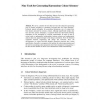Free Online Productivity Tools
i2Speak
i2Symbol
i2OCR
iTex2Img
iWeb2Print
iWeb2Shot
i2Type
iPdf2Split
iPdf2Merge
i2Bopomofo
i2Arabic
i2Style
i2Image
i2PDF
iLatex2Rtf
Sci2ools
96
Voted
APCHI
2004
IEEE
2004
IEEE
Nine Tools for Generating Harmonious Colour Schemes
We survey a number of tools that have been developed for generating sets of colours according to commonly accepted rules for colour harmony. Informal manual techniques for generating harmonious sets of colours have been known and used for at least a century. Although superficially simple, they have not been precise techniques, as pigment-based and dye-based colouring techniques are not susceptible to accurate measurement, in terms of area of colour used or mathematical relationships between colours, and mathematical analysis does not appeal strongly to the design community. Now the historical separation between engineering and design has narrowed. First, the development of colour television brought numerical precision into colour specification. Secondly, in computers, the medium for colour representation and the tool for calculating colour parameters have been integrated. Consequently, it has also become feasible to derive sets of harmonious colours automatically.
| Added | 20 Aug 2010 |
| Updated | 20 Aug 2010 |
| Type | Conference |
| Year | 2004 |
| Where | APCHI |
| Authors | Paul J. Lyons, Giovanni S. Moretti |
Comments (0)

